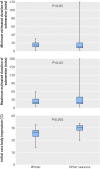Outcome after resuscitation beyond 30 minutes in drowned children with cardiac arrest and hypothermia: Dutch nationwide retrospective cohort study
- PMID: 25670715
- PMCID: PMC4353310
- DOI: 10.1136/bmj.h418
Outcome after resuscitation beyond 30 minutes in drowned children with cardiac arrest and hypothermia: Dutch nationwide retrospective cohort study
Abstract
Objectives: To evaluate the outcome of drowned children with cardiac arrest and hypothermia, and to determine distinct criteria for termination of cardiopulmonary resuscitation in drowned children with hypothermia and absence of spontaneous circulation.
Design: Nationwide retrospective cohort study.
Setting: Emergency departments and paediatric intensive care units of the eight university medical centres in the Netherlands.
Participants: Children aged up to 16 with cardiac arrest and hypothermia after drowning, who presented at emergency departments and/or were admitted to intensive care.
Main outcome measure: Survival and neurological outcome one year after the drowning incident. Poor outcome was defined as death or survival in a vegetative state or with severe neurological disability (paediatric cerebral performance category (PCPC) ≥ 4).
Results: From 1993 to 2012, 160 children presented with cardiac arrest and hypothermia after drowning. In 98 (61%) of these children resuscitation was performed for more than 30 minutes (98/160, median duration 60 minutes), of whom 87 (89%) died (95% confidence interval 83% to 95%; 87/98). Eleven of the 98 children survived (11%, 5% to 17%), but all had a PCPC score ≥ 4. In the 62 (39%) children who did not require prolonged resuscitation, 17 (27%, 16% to 38%) survived with a PCPC score ≤ 3 after one year: 10 (6%) had a good neurological outcome (score 1), five (3%) had mild neurological disability (score 2), and two (1%) had moderate neurological disability (score 3). From the original 160 children, only 44 were alive at one year with any outcome.
Conclusions: Drowned children in whom return of spontaneous circulation is not achieved within 30 minutes of advanced life support have an extremely poor outcome. Good neurological outcome is more likely when spontaneous circulation returns within 30 minutes of advanced life support, especially when the drowning incident occurs in winter. These findings question the therapeutic value of resuscitation beyond 30 minutes in drowned children with cardiac arrest and hypothermia.
© Kieboom et al 2015.
Conflict of interest statement
Competing interests: All authors have completed the ICMJE uniform disclosure form at
Figures







Comment in
-
Resuscitating drowned children.BMJ. 2015 Feb 10;350:h535. doi: 10.1136/bmj.h535. BMJ. 2015. PMID: 25670714 No abstract available.
References
-
- World Health Organization. Factsheet on drowning. www.who.int/mediacentre/factsheets/fs347/en/index.html.
-
- Centers for Disease Control and Prevention (CDC). Drowning—United States, 2005-2009. MMWR Morb Mortal Wkly Rep 2012;61:344-7. - PubMed
-
- Venema AM, Groothoff JW, Bierens JJ. The role of bystanders during rescue and resuscitation of drowning victims. Resuscitation 2010;81:434-9. - PubMed
-
- Suominen P, Baillie C, Korpela R, Rautanen S, Ranta S, Olkkola KT. Impact of age, submersion time and water temperature on outcome in near-drowning. Resuscitation 2002;52:247-54. - PubMed
-
- Quan L, Kinder D. Pediatric submersions: prehospital predictors of outcome. Pediatrics 1992;90:909-13. - PubMed
Publication types
MeSH terms
LinkOut - more resources
Full Text Sources
Other Literature Sources
Medical
